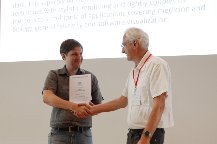July 4, 2023; Christina Warren
At this year’s EuroVis conference, former SFB-TRR 161 researcher and MGK manager Christoph Schulz received the EuroVis PhD Award for his dissertation “Uncertainty-aware Visualization Techniques”. Congratulations! The EuroVis PhD Award is granted for outstanding dissertations on visualization-related topics to recognize excellent young researchers in their early career and to highlight visualization research. The award ceremony took place during the conference in Leipzig.
Dissertation Abstract
Nearly all information is uncertainty-afflicted. Whether and how we present this uncertainty can have a major impact on how our audience perceives such information. Still, uncertainty is rarely visualized and communicated. One difficulty is that we tend to interpret illustrations as truthful. For example, it is difficult to understand that a drawn point’s presence, absence, and location may not convey its full information. Similarly, it may be challenging to classify a point within a probability distribution. One must learn how to interpret uncertainty-afflicted information. Accordingly, this thesis addresses three research questions: How can we identify and reason about uncertainty? What are approaches to modeling flow of uncertainty through the visualization pipeline? Which methods are suitable for harnessing uncertainty? The first chapter is concerned with sources of uncertainty. Then, approaches to model uncertainty using descriptive statistics and unsupervised learning are discussed. Also, a model for validation and evaluation of visualization methods is proposed. Further, methods for visualizing uncertainty-afflicted networks, trees, point data, sequences, and time series are presented. The focus lies on modeling, propagation, and visualization of uncertainty. As encodings of uncertainty, we propose wave-like splines and sampling-based transparency. As an overarching approach to adapt existing visualization methods for uncertain information, we identify the layout process (the placement of objects). The main difficulty is that these objects are not simple points but distribution functions or convex hulls. We also develop two stippling-based methods for rendering that utilize the ability of the human visual system to cope with uncertainty. Finally, I provide insight into possible directions for future research.
News and Press
Looking for an Expert?
The Project Leaders of the SFB-TRR 161 are experts in the field of visual computing. You are welcome to get in touch directly.
If you need help finding the right contact for your inquiry, please contact the Public Relations Team.
BOGY in der Forschung?
Du möchtest schon während der Schulzeit die Welt der Forschung kennenlernen? Du möchtest dich über die Studiengänge an unseren Transregio Partnern informieren? Du programmierst gerne oder interessierst dich für Informatik und Computergrafik?
Ein BOGY im SFB-TRR 161 gibt dir die Chance, dich mit unseren Forschern auszutauschen und in die Arbeitswelt der Wissenschaft einzutauchen.
FOR SCIENTISTS
Projects
People
Publications
Graduate School
Equal Opportunity
FOR PUPILS
PRESS AND MEDIA
© SFB-TRR 161 | Quantitative Methods for Visual Computing | 2019.







